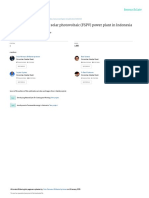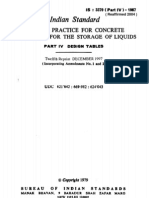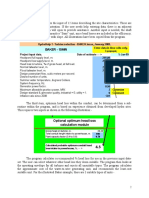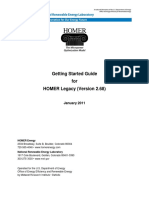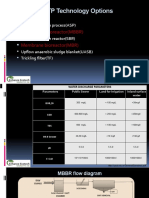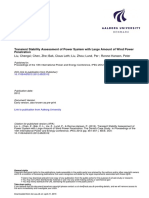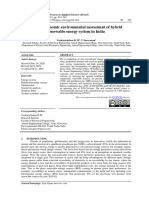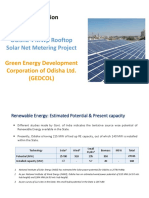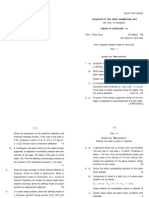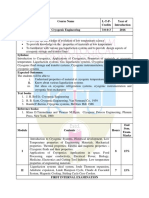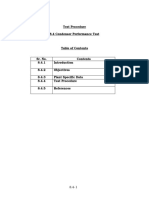Integration of Solar and Wind Energy System For Hybrid Power Generation
Integration of Solar and Wind Energy System For Hybrid Power Generation
Uploaded by
Deepak sutarCopyright:
Available Formats
Integration of Solar and Wind Energy System For Hybrid Power Generation
Integration of Solar and Wind Energy System For Hybrid Power Generation
Uploaded by
Deepak sutarOriginal Description:
Original Title
Copyright
Available Formats
Share this document
Did you find this document useful?
Is this content inappropriate?
Copyright:
Available Formats
Integration of Solar and Wind Energy System For Hybrid Power Generation
Integration of Solar and Wind Energy System For Hybrid Power Generation
Uploaded by
Deepak sutarCopyright:
Available Formats
IOSR Journal of Engineering (IOSRJEN) www.iosrjen.
org
ISSN (e): 2250-3021, ISSN (p): 2278-8719
Volume 8, PP 11-15
Integration of Solar and Wind Energy System for Hybrid Power
Generation
Varad Bagwe1, Abhijeet Thoke2, Charchit Vatsa3, Dibyanshu Pandey4,
Sangeeta Kotecha5
1
(Electrical Engineering Department, Atharva College of Engineering, Mumbai, India)
2
(Electrical Engineering Department, Atharva College of Engineering, Mumbai, India)
3
(Electrical Engineering Department, Atharva College of Engineering, Mumbai, India)
4
(Electrical Engineering Department, Atharva College of Engineering, Mumbai, India)
5
(Electrical Engineering Department, Atharva College of Engineering, Mumbai, India)
Corresponding Author: Varad Bagwe
Abstract: With the increased global warming concern it is becoming important to find an alternative to
conventional energy sources causing less pollution and leading to sustainable use of available resources. This
has encouraged renewable energy generation to become a leader in energy sector but the main obstacle in its
path is its cost effectiveness. This has motivated for combining two or more renewable energy resources i.e.
hybrid power generation. The paper deals with the study and design of hybrid system of solar and wind energy
for rural area’s electrification
Keywords - Flexible solar panels, hybrid power system, PWM charge controller, rural electrification, sine
wave inverter, and vertical axis wind turbine.
I. Introduction
Solar and wind hybrid generation is most popular power generation method as these are available
readily everywhere. This paper focuses on design aspects and fabrication of hybrid power generation model.
Hybrid energy generation is turning out to be a more popular method of distributing electricity in rural areas and
in urban areas as well where the land constraint play a major role. Hybrid model proposed here combines solar
panels and vertical axis wind turbine and provides continuous supply with increased reliability [5] [6]. This
Hybrid renewable Generation system can become the best solution for feeding the mini-grids and isolated loads
in remote areas. The system can also provide an answer for the individual energy concern. Higher total energy
efficiency, improved operational performance, dispatch and operational control can be obtained through the
proper technology selection and generation unit sizing. Researchers and engineers are developing different
configurations to utilize the system component effectively. The figures below show such two kinds of
arrangements used for the hybrid generation system.
Figure1: Different configurations used for solar-Wind hybrid generation system
International Conference on Innovative and Advanced Technologies in Engineering (March-2018) 11 |Page
Integration of Solar and Wind Energy System for Hybrid Power Generation
Horizontal axis wind turbine system, which is most of the time used in wind farm, produces energy
generally in MW; but its installation and maintenance cost are high whereas the vertical axis machines are
cost and size effective, hence useful for small scale applications [1][7]. Many countries are also providing
fund and assistance for building it in order to satisfy the need of electricity. In India, central as well as state
governments are spreading awareness and guiding people for its expansion. Maharashtra State Energy
Development Agency (MEDA) is one of government institution, who promotes renewable energy systems.
Following list shows year wise achievement of wind and solar hybrid systems and its progress in the state of
Maharashtra, India.
Figure 2: Progress of solar-wind hybrid system in Maharashtra state
II. Design Prerequisite and Criteria
The data collection and analysis included energy requirements, mean annual hourly wind speed in
m/s, location of installation and installation structure, energy storage system, annual mean daily duration of
sunshine hours and daily horizontal solar radiation in Kwh/m2/day. The calculations of electricity generation
estimation from the wind turbine, system installation capacity and battery sizing are done based on data
analysis and load requirement. The charge controller and inverter are designed and fabricated for the proposed
model.
Figure3: Block diagram of the process flow for data reacquisition
1. Analysis of Energy Requirement:
This is the foremost step which needs to be carried out, where the load which the hybrid plant will be
supplying is selected. Load flow studies may also be performed while analyzing the load which will be
powered by the hybrid plant.
2. Wind Power Calculations:
The size of the wind blades and the wind speed (in m/s) values are substituted in the formula below,
which yields the wind power which will be available for energy generation
International Conference on Innovative and Advanced Technologies in Engineering (March-2018) 12 |Page
Integration of Solar and Wind Energy System for Hybrid Power Generation
The power generated by wind energy is given by,
Power = (density of air * swept area*velocity cubed)/2
3
PW = ½* ñ* (AW)* (V)
Where,
P is power in watts (W).
ñ is the air density in kilograms per cubic meter (kg/m³).
AW is the area swept by air in square meters (m²).
V is the wind speed in meters per second (m/s).
3. Solar Power Calculation:
To determine the size of PV modules, the required energy consumption must be estimated. Therefore, the power
is calculated as
Solar Power = Ir * A*Eff (PV)
Where,
2
Ir is the Irradiance (W/ m ) at the plant location.
2A is the Area of single PV panel (m ).
Eff (PV) is the overall efficiency of the PV panels and dc/dc converters.
4. Energy Storage System:
The Energy storage system is chosen according to the load and as per the requirements. A number of studies
also need to be conducted in order to select the Storage system which best fits the particular load constraints.
III. System Description and Working
In the proposed model, a charge controller is used to regulate the power generated by both solar
panels and the wind turbine [3]. It also simultaneously charges battery and gives power to the load. The
controller has over-charge protection and short-circuits protection. A specifically chosen battery is used to
store the generated power.
Figure 4: Block Diagram of proposed system
IV. Pwm Charge Controller Design and Invertors
Charge controller:
A Charge controller, considered as a heart of solar generation system, is used to regulate the voltages and
current coming from the solar panels and wind generator. It regulates the charge to the batteries
preventing any overcharging.
Types of charge controller are:
1. ON OFF2. PWM 3. MPPT
ON OFF type is the simplest type with just monitoring the battery voltages and currents and opening,
stopping, closing the circuit according the battery voltage rise to predefined level. MPPT is the one with
high efficiency and cost, whereas PWM is simpler and cost-effective [2].
International Conference on Innovative and Advanced Technologies in Engineering (March-2018) 13 |Page
Integration of Solar and Wind Energy System for Hybrid Power Generation
Figure 5: Flow diagram of working of charge controller
A Charge controller has higher charging efficiency, reduces battery overheating, and minimizes stress
on battery, which ensures longer battery life. This charge controller is made using Arduino nano board.
According to the difference in solar generator voltage, wind generator voltage and battery voltage, Arduino
decides the extent and duration of charging. The difference between the battery voltage and set point voltages,
determines the charging current. Fixed frequency of PWM signal to the solar panel side of P-MOSFET is
490.20 Hz. The duty cycle is varied from 0-100%, as the error signal changes. According to standard practices,
the sizing of solar charge controller is to take short circuit current of the PV array, and multiply it by 1.3. So if
PV module have Isc rating as 7.5 A and there are 4 panels then solar charge controller rating will be greater
than (4*7.5) 39 A, hence a 40 A current rated inverter will be fine.
Inverter:
Inverter ratings depend upon the load of the system. There are three basics types of inverter, they are:-
1. Square wave
2. Modified sine wave
3. Pure sine wave
Out of these three types the pure sine wave inverter is the most suitable type for all appliances. For standalone
system the inverter must be large enough to handle the total amount of watts using at a time. The inverter must
have same nominal voltage as battery. The inverter size should be 20-30% more than the total watts of
appliances. So for a load of 153 W, inverter will be of 190 W. For grid tie systems or grid connected systems,
the rating of the inverter should be same as PV array rating to allow for safe and efficient operation.
V. Results and Discussion
This paper provides a summary of available approaches and those currently under research for
optimal design of hybrid renewable energy systems. The Current statuses, research, vision for the future of
RE power generation technologies have been discussed. The review has also discussed the efficiency
calculations and procedure required in development of hybrid RE systems. The resulting energy system
serves local stationary and LV-based mobile consumers, and it is a good citizen within the main grid as it
reduces emissions by local usage of wind and solar energy. The solar and wind generator power outputs can
be maximized using MPPT control systems and algorithms. It was also observed that wind and solar are
complementary since sunny days are usually calm and strong winds are often accompanied by cloud and
may occur at night. The charging of the battery by the wind turbine greatly depends on the rotational speed
of the blade which in turn depends on the wind speed. As the machine size is small, cost of machine is
comparatively lower than the available power generator and can easily be installed where the power
requirement is small like on the terrace of building, gardens, commercial buildings, small industries etc. The
only advantage at which this system lacks is that the initial and installation cost of machine is higher
compare to available energy generating systems, but it can be recovered within few years as it has very less
maintenance cost. Energy generated after breakeven point is very cheaper compare to available energy.
International Conference on Innovative and Advanced Technologies in Engineering (March-2018) 14 |Page
Integration of Solar and Wind Energy System for Hybrid Power Generation
Overall it is a reliable and affordable solution for electricity generation.
VI. Conclusion
A hybrid power generation system is better solution for power generation than conventional energy
resources especially in rural areas where electricity is not stable or absent. The power generated can be
utilized in situ thereby reducing transmission losses and cost. The designed hybrid system is very compact,
easy to install and ensures no power failure by solar during the day and wind during the night. As the idea is in
its initial stage, so productive changes may be implemented in later stages. It is highly safe for the
environment having long life span and only need initial investment thus overall it is good, reliable and
affordable solution for electricity generation.
VII. Future Scope
The proposed hybrid system model can also be erected in the path of rail road where high pressure of
wind is developed by motion of the train. When manufactured on a large scale, power generation cost of this
system will reduce. Excitonic solar cells can be used which has Tatiana nanotube arrays that shows
considerable promise to harness a larger fraction of the solar spectrum. This will ultimately make this system
more reliable and efficient. India recently proposed to augment cooking, lighting, and motive power with
renewable in 600,000 villages by 2032, starting with 10,000 remote UN-electrified villages by 2012. India’s
new feed-in tariff was capped at 50 MW through 2009, although a second policy phase may increase the
program cap to 1,000 MW. The tariff provides up to 12 Rupees per kWh for Solar PV projects promising a
10-year commitment with a cap of 50 MW. The proposed system can provide power to remote places where
government is unable to reach. This will reduce the transmission losses and cost. By interconnecting these
systems load sharing can be done. The power to the loads can be equally shared. Thus the power can be
regularized.
References
[1] Terrence C. Sankar, The case for vertical axis wind turbines, Proc. of clean Technology Conf. and Trade ShowPittsburgh, PA, 2008,
136 -139.
[2] Gazi, S.M. Mahaiminul, I and Salim, K.M (2009); Design and construction of Microcontroller Based Maximum Power Point
[3] stPWM Charge Controller for Photovoltaic Application. Development in Renewable Energy Technology (2009) 1
internationaConference, Pp. 1-4.
[4] Enric, P.U. and Micheal M.D. (1998); Recommended Practices for Charge Controllers. Renewable Energy and Hybrid System
Group CANMET Energy Diversification Research Laboratory
[5] P N Shankar,Development of vertical axis wind turbines, National Aeronautical Laboratory, Bangalore, C 2, 1979, 49- 66.
[6] Climate change, Global Risks, Challenges and Decisions, Synthesis Report, 2009.
[7] M. R. Patel, Wind and Solar Power Systems, (CRC Press Florida1999).
[8] Burton T., Sharpe D., Jenkins N., Bossanyi E., Wind Energy Handbook, (England:John Wiley & Sons Ltd. 2001) 41-170.
[9] H. P. Garg, J. Prakash, Solar Energy Fundamentals and Applications (Tata McGraw-Hill Ltd New Delhi,2002).
International Conference on Innovative and Advanced Technologies in Engineering (March-2018) 15 |Page
You might also like
- Image Analysis Method For Quantifying Snow Losses On PV SystemsDocument7 pagesImage Analysis Method For Quantifying Snow Losses On PV SystemsJennifer BraidNo ratings yet
- Design of An Exhaust Air Energy Recovery Wind Turbine Generator For Energy Conservation in Commercial BuildingsDocument12 pagesDesign of An Exhaust Air Energy Recovery Wind Turbine Generator For Energy Conservation in Commercial BuildingsDanang JoyoeNo ratings yet
- Lectures On Quantum Mechanics For Mathematics Students Student Mathematical LibraryDocument124 pagesLectures On Quantum Mechanics For Mathematics Students Student Mathematical LibrarywillmateNo ratings yet
- Wind Solar HybridDocument14 pagesWind Solar HybridmpurperNo ratings yet
- Design Floating PVDocument9 pagesDesign Floating PVAchmad HidayatNo ratings yet
- SP3.6 Array Voltage ConsiderationsDocument8 pagesSP3.6 Array Voltage ConsiderationsSIDI ahmedou yahyaNo ratings yet
- Hydraulics and Hydraulic Machinery 2009 JNTUK QUESTION PAPERDocument8 pagesHydraulics and Hydraulic Machinery 2009 JNTUK QUESTION PAPERhimabindugvsd71No ratings yet
- Solar Irrigation SystemDocument18 pagesSolar Irrigation SystemHarishwar ReddyNo ratings yet
- (Guidelines) (2) Jumeirah Village Landscape CodeDocument39 pages(Guidelines) (2) Jumeirah Village Landscape CodeKarthikeyan SankarrajanNo ratings yet
- PV Array Design Worksheet Determine The Array Size For Your Grid-Connected System.Document6 pagesPV Array Design Worksheet Determine The Array Size For Your Grid-Connected System.موج البحرNo ratings yet
- Solar Water Pumpimp PDFDocument21 pagesSolar Water Pumpimp PDFArafath AmerNo ratings yet
- Is Code3370 - 4Document51 pagesIs Code3370 - 4thirumalaichettiarNo ratings yet
- 2020 - Grid-Scale Energy Storage Hazard Analysis - Design Objectives For System Safety-AnnotatedDocument61 pages2020 - Grid-Scale Energy Storage Hazard Analysis - Design Objectives For System Safety-Annotatedmariaocastillo0966No ratings yet
- ACC WE DB3120S Solar Domestic Hot Water GuidelinesDocument17 pagesACC WE DB3120S Solar Domestic Hot Water GuidelinestienlamNo ratings yet
- Hybrid Solar, Wind, and Energy Storage System For A SustainableDocument12 pagesHybrid Solar, Wind, and Energy Storage System For A SustainabledaaanuNo ratings yet
- Modeling and Sizing Optimization of Hybrid Wind and PV SystemDocument24 pagesModeling and Sizing Optimization of Hybrid Wind and PV SystemD Avi Na Sh0% (1)
- Mer We Dd3320 Electricity DiagramsDocument10 pagesMer We Dd3320 Electricity DiagramstienlamNo ratings yet
- Specification For Inverter 15-03Document2 pagesSpecification For Inverter 15-03Văn ST QuangNo ratings yet
- Baker - 10Mw: Optional Optimum Head Loss Calculation ModuleDocument1 pageBaker - 10Mw: Optional Optimum Head Loss Calculation ModuleamoghimiNo ratings yet
- Homer Getting Started 268Document28 pagesHomer Getting Started 268bakien-canNo ratings yet
- STP Technology Options: Moving Bed Bioreactor (MBBR) Membrane Bioreactor (MBR)Document6 pagesSTP Technology Options: Moving Bed Bioreactor (MBBR) Membrane Bioreactor (MBR)amzad aliNo ratings yet
- Solar Powered Water Pumping Systems: AbstractDocument4 pagesSolar Powered Water Pumping Systems: AbstractbalaNo ratings yet
- Table of Content 1. Structure Steel Bridge 2 Block Classroom Blok Perubatan Canteen Prayer RoomDocument15 pagesTable of Content 1. Structure Steel Bridge 2 Block Classroom Blok Perubatan Canteen Prayer RoomIr Ahmad AfiqNo ratings yet
- SMA Catalogo 2010 - 11 - en PDFDocument222 pagesSMA Catalogo 2010 - 11 - en PDFluca2527No ratings yet
- Solar Power PlantDocument69 pagesSolar Power PlantMark Anthony Lluvido PlatinoNo ratings yet
- Sag and Tension of Transmission and Distribution LinesDocument2 pagesSag and Tension of Transmission and Distribution Linesjob_pNo ratings yet
- Transmission and Distribution Design WordDocument31 pagesTransmission and Distribution Design WordKeshav Raj SharmaNo ratings yet
- Floating Solar JournalDocument6 pagesFloating Solar JournalPrabuVijayNo ratings yet
- 908design of High Efficiency Cross-Flow TurbineDocument4 pages908design of High Efficiency Cross-Flow TurbineAdi Setiadi100% (1)
- Specification Grid Tie SPV PlantDocument24 pagesSpecification Grid Tie SPV PlantAnonymous iNZUlcNo ratings yet
- Hydro Power Plant-6Document23 pagesHydro Power Plant-6Shruthi Ganesh100% (1)
- Tribhuwan University Institute of Engineering Pashchimanchal CampusDocument38 pagesTribhuwan University Institute of Engineering Pashchimanchal CampusSameep KhanalNo ratings yet
- Canal Top Solar Energy Harvesting Using ReflectorDocument6 pagesCanal Top Solar Energy Harvesting Using ReflectorGRD JournalsNo ratings yet
- Pole No. Number and Type of Transformer Lighting Refrigerator Electric Range Water Heater Maximum Demand KVADocument6 pagesPole No. Number and Type of Transformer Lighting Refrigerator Electric Range Water Heater Maximum Demand KVAmaria neneng bulakNo ratings yet
- Matthias Hermes - The Role of PV Inverters and System TechnologyDocument46 pagesMatthias Hermes - The Role of PV Inverters and System TechnologyADB_SAEN_ProjectsNo ratings yet
- Design and Analysis of A Grid-Connected Photovoltaic Power SystemDocument9 pagesDesign and Analysis of A Grid-Connected Photovoltaic Power SystemnmotanNo ratings yet
- Transient Stability Assessment of Power System With Large Amount of Wind Power Penetration The Danish Case StudyDocument8 pagesTransient Stability Assessment of Power System With Large Amount of Wind Power Penetration The Danish Case StudyThức VõNo ratings yet
- Photovoltaics Residential Sector - 2Document50 pagesPhotovoltaics Residential Sector - 2Nourhan Ahmed AliNo ratings yet
- Design of The Rotor Blades of A Mini Hydraulic Bulb-TurbineDocument9 pagesDesign of The Rotor Blades of A Mini Hydraulic Bulb-TurbineuroskNo ratings yet
- 11 UOL Ireland Induction HobsDocument17 pages11 UOL Ireland Induction HobsChainReactionDeNo ratings yet
- Nrel PV String To 3-Phase Inverter With The Highest V CapabilitiesDocument38 pagesNrel PV String To 3-Phase Inverter With The Highest V CapabilitieshaniNo ratings yet
- EirGrid - Solutions For Mitigating Technical Challenges Arising Due To RESDocument106 pagesEirGrid - Solutions For Mitigating Technical Challenges Arising Due To RESIBA PUNo ratings yet
- Designing and Installation of 4KWp On-Grid Solar PV Plant A Case Study of An Academic InstituteDocument5 pagesDesigning and Installation of 4KWp On-Grid Solar PV Plant A Case Study of An Academic InstituteMohammed Shariq AyjazNo ratings yet
- Techno Economic Environmental Assessment of Hybrid Renewable Energy System in IndiaDocument20 pagesTechno Economic Environmental Assessment of Hybrid Renewable Energy System in IndiaInternational Journal of Advances in Applied Sciences (IJAAS)No ratings yet
- 4MW RTS Project Initiated by GEDCOL, OdishaDocument29 pages4MW RTS Project Initiated by GEDCOL, Odishamailnehru8955No ratings yet
- ME5521 Chapter1 1 2011Document77 pagesME5521 Chapter1 1 2011Sebastián EspinozaNo ratings yet
- Chapter - 1 1.1 OverviewDocument21 pagesChapter - 1 1.1 OverviewTirumalarao PechettyNo ratings yet
- Two-Stage Micro-Grid Inverter With High PDFDocument10 pagesTwo-Stage Micro-Grid Inverter With High PDFacostaricciNo ratings yet
- Acc We Gg1001 Elec Safety BathroomDocument10 pagesAcc We Gg1001 Elec Safety BathroomtienlamNo ratings yet
- Hydroelectric Power PlantDocument19 pagesHydroelectric Power PlantMark MarkNo ratings yet
- Grid Tie Inverter MarketDocument8 pagesGrid Tie Inverter MarketSubhrasankha BhattacharjeeNo ratings yet
- Wind Turbine Generators: © P. KundurDocument24 pagesWind Turbine Generators: © P. Kunduravillanueva_1No ratings yet
- Power System PresentationDocument10 pagesPower System PresentationBayeNo ratings yet
- Wind Energy: Process of Wind CreationDocument4 pagesWind Energy: Process of Wind CreationmariyaNo ratings yet
- Pitch Analysis PaperDocument7 pagesPitch Analysis PaperMunib MunirNo ratings yet
- Renewable Energy Tariffs and Incentives in Indonesia: Review and RecommendationsFrom EverandRenewable Energy Tariffs and Incentives in Indonesia: Review and RecommendationsNo ratings yet
- EMS For Small Scale Hybrid Wind Solar Battery Based MicrogridDocument10 pagesEMS For Small Scale Hybrid Wind Solar Battery Based MicrogridkartikNo ratings yet
- Using Y-Source Network As A Connector Between Turbine and Network in The Structure of Variable Speed Wind TurbineDocument15 pagesUsing Y-Source Network As A Connector Between Turbine and Network in The Structure of Variable Speed Wind TurbineInternational Journal of Power Electronics and Drive SystemsNo ratings yet
- Ijrdet 0414 21Document13 pagesIjrdet 0414 21teju2812No ratings yet
- Abstract Raj KishanDocument4 pagesAbstract Raj KishanShreya SinghNo ratings yet
- SYNOPSIS-Mango Cutting MachineDocument7 pagesSYNOPSIS-Mango Cutting MachineDeepak sutarNo ratings yet
- Shield Technologies Poster-With Logo PDFDocument1 pageShield Technologies Poster-With Logo PDFDeepak sutarNo ratings yet
- Civil TopicsDocument1 pageCivil TopicsDeepak sutarNo ratings yet
- List of CompDocument2 pagesList of CompDeepak sutarNo ratings yet
- Agricultural Projects Mechanical Engineering ProjectsDocument2 pagesAgricultural Projects Mechanical Engineering ProjectsDeepak sutarNo ratings yet
- List of CompDocument2 pagesList of CompDeepak sutarNo ratings yet
- Shield Technology Mechanical On Going Projects: SL No Project Tittle DateDocument2 pagesShield Technology Mechanical On Going Projects: SL No Project Tittle DateDeepak sutarNo ratings yet
- Automatic Waste Segregator and Monitoring System: January 2016Document8 pagesAutomatic Waste Segregator and Monitoring System: January 2016Deepak sutarNo ratings yet
- Fabrication of Turbocharger For Two Wheeler: Ahir Nischal A, Sofia Ali A, Darshan S Shah, Sneh R PrajapatiDocument8 pagesFabrication of Turbocharger For Two Wheeler: Ahir Nischal A, Sofia Ali A, Darshan S Shah, Sneh R PrajapatiDeepak sutarNo ratings yet
- Shield Technology Mechanical On Going Projects: SL No Project Tittle DateDocument2 pagesShield Technology Mechanical On Going Projects: SL No Project Tittle DateDeepak sutarNo ratings yet
- Three Axis TrailerDocument9 pagesThree Axis TrailerDeepak sutarNo ratings yet
- BoilingDocument1 pageBoilingDeepak sutarNo ratings yet
- Iarjset-Ncdmete 13 PDFDocument5 pagesIarjset-Ncdmete 13 PDFDeepak sutar100% (1)
- Osborn Roadsweeping EnglishDocument36 pagesOsborn Roadsweeping EnglishDeepak sutarNo ratings yet
- Iarjset-Ncdmete 13Document48 pagesIarjset-Ncdmete 13Deepak sutarNo ratings yet
- Three Axis Pneumatic Modern TrailerDocument15 pagesThree Axis Pneumatic Modern TrailerDeepak sutarNo ratings yet
- Humidity Sensor: Key Kai WongDocument15 pagesHumidity Sensor: Key Kai WongDeepak sutarNo ratings yet
- CV Carbs: The Venturi EffectDocument5 pagesCV Carbs: The Venturi EffectiskebikerNo ratings yet
- Theory of Structures IV Question PaperDocument2 pagesTheory of Structures IV Question PaperSourav SilNo ratings yet
- (Mai 1.8 Complex Numbers (Cartesian Form)Document18 pages(Mai 1.8 Complex Numbers (Cartesian Form)Dania QistinaNo ratings yet
- Adobe Scan 03-Apr-2024Document12 pagesAdobe Scan 03-Apr-2024Pradeep chaturvediNo ratings yet
- Terziev Etal AOR 2019 A Geosim Analysis of Ship Resistance Decomposition and Scale EffectsDocument36 pagesTerziev Etal AOR 2019 A Geosim Analysis of Ship Resistance Decomposition and Scale EffectsMuhammad Osama SaeedNo ratings yet
- 1 PEAB ZC311 Assignment IDocument2 pages1 PEAB ZC311 Assignment IM Helmy Aditya100% (1)
- AERC Supply Code Regulation 3rd Amendment 2020Document5 pagesAERC Supply Code Regulation 3rd Amendment 2020Partha HazarikaNo ratings yet
- Anil Kumar - Refractive Indices of (A) Water (B) OilDocument13 pagesAnil Kumar - Refractive Indices of (A) Water (B) OilDeepak SharmaNo ratings yet
- Crouzet M3CatalogDocument92 pagesCrouzet M3CatalogMarceloNo ratings yet
- Siwes Report CHISOM SAM ORJIDocument41 pagesSiwes Report CHISOM SAM ORJISOMSKI1100% (2)
- Interaction Between Ceria Nad Hydroxylamine - TamilmaniDocument6 pagesInteraction Between Ceria Nad Hydroxylamine - TamilmaniUmarameshKNo ratings yet
- Discussion of Extended Drucker-Prager Yield Criterion in Slope Stability AnalysisDocument4 pagesDiscussion of Extended Drucker-Prager Yield Criterion in Slope Stability AnalysisAbdelmoez ElgarfNo ratings yet
- Final Exam: Functional Performance Testing: Technical vs. Process CommissioningDocument9 pagesFinal Exam: Functional Performance Testing: Technical vs. Process CommissioningBen MusimaneNo ratings yet
- ME467 Cryogenic EngineeringDocument2 pagesME467 Cryogenic Engineeringnandan144No ratings yet
- 2012 2009 1080p AC3 (Dolby) 5 1ch Blu-Ray PS3-TEAM-engDocument150 pages2012 2009 1080p AC3 (Dolby) 5 1ch Blu-Ray PS3-TEAM-engCristian SimaNo ratings yet
- Section PropertiesDocument92 pagesSection PropertiesNiranjanAryanNo ratings yet
- Jai ResumeDocument3 pagesJai ResumeJagan NathanNo ratings yet
- Test Procedure 8.4 Condenser Performance TestDocument19 pagesTest Procedure 8.4 Condenser Performance TestLakshmi Narayan100% (2)
- GasketsDocument20 pagesGasketsParthiban NagarajanNo ratings yet
- Microsoft Word - Document1asdgfvxDocument8 pagesMicrosoft Word - Document1asdgfvxVishakha KendreNo ratings yet
- Semiconductor Lesson PlanDocument10 pagesSemiconductor Lesson Plana000ryaNo ratings yet
- How Is Damping Quantified?: Henrik SönnerlindDocument11 pagesHow Is Damping Quantified?: Henrik SönnerlindAyoub FriginiNo ratings yet
- Automated Design of Steel Trusses PDFDocument12 pagesAutomated Design of Steel Trusses PDFNasriyah SolaimanNo ratings yet
- Pavement Design ManualDocument295 pagesPavement Design ManualkonstantanolNo ratings yet
- MM850102-03 UniCal RTDDocument43 pagesMM850102-03 UniCal RTDctmtectrolNo ratings yet
- Homework 3 SolutionDocument12 pagesHomework 3 SolutionTACN-2T?-19ACN Nguyen Dieu Huong LyNo ratings yet
- Descriptive Essay RubricDocument2 pagesDescriptive Essay Rubricapi-249581442No ratings yet
- Theory of YieldingDocument10 pagesTheory of YieldingrasprasadNo ratings yet
- Ceramic SaddlesDocument2 pagesCeramic SaddlestanveerpuNo ratings yet




